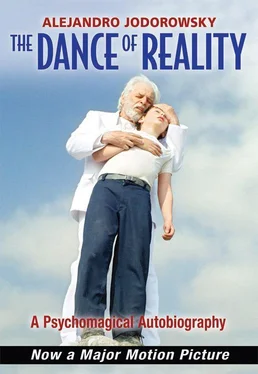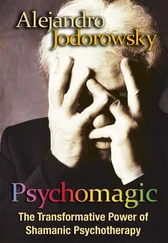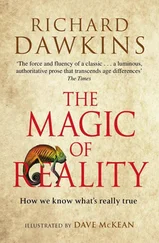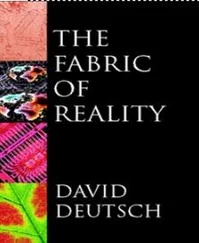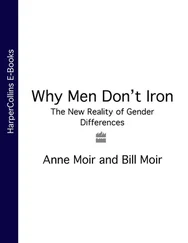It appeared to me that the scientists spoke mostly of phantom parts of the body, such as limbs, and never of a whole phantom body. I allowed myself to consider that we might have a whole phantom body: an immaterial body veiled by the flesh that exists before any amputation takes place and that has sensations. The experimenters had also encountered blind patients who saw phantom sights and deaf patients who heard phantom sounds.
Some amputees feel excruciating pain in their absent limbs. The neurologists, thinking that the perceived but intangible body parts were not real, could not alleviate these pains, even though they performed operations, desensitizing the cutaneous areas over the stump and also on the torso, where they believed the topological sensations creating the phantom limb originated. I wondered, “What if we were to accept the phantom limb as real and soothe its pain by operating on it? If the limb can feel the presence of a ring or a watch, could it not feel the touch of a scalpel?” I understood the aspect that was missing from my initiatory massages: we do not perceive the body as it is; we are only aware of a material representation of it that is adulterated by the views of others. We do not feel everything we feel, we do not see everything we see, and we do not hear everything we hear; there are tastes and odors that are captured by the tongue and sense of smell but not by the consciousness. With the initiatory massage, I had dedicated myself to cleansing the tangible body without acting on the phantom body. I concluded that Pachita and other witches, when they operated, did not do so on the material body, but acted on the intangible phantom body. Except that with their tricks, they added visible elements such as blood, entrails, and so on, so that the patients would believe that they were operating on their “real” bodies.
I decided to eliminate everything that was intended to deceive the primitive, superstitious spirit and to proceed to operate in all honesty without any kind of gimmick. In the same way that a state of mind changes the body’s attitude, a bodily attitude modifies the state of mind. Moreover, just as what happens to the material body affects the phantom body, what is done to the phantom body affects the material body. Based on this belief, I imagined a psychoshamanic ritual. The shaman acts in his medium, using his surroundings, plants, and animals as elements of power. But the psychoshaman, not imitating that which he is not and which belongs to a different culture, uses the elements provided by his environment, namely the city. A mobile phone, a vacuum cleaner, a car, or supermarket products are as magical as a snake, a fan of feathers, or a mushroom. The psychoshaman does not wear exotic clothes, necklaces, or other ornaments. A typical suit, preferably black for neutrality, will suffice. He does not operate in the shadows, lit by a single candle. He appropriates the words of the poet Arthur Cravan: “mystery in broad daylight.” And, since the act is metaphorical, he does not wield any knife; if it is necessary to symbolize one, a wooden ruler suffices. He never operates in his own name, an attitude consistent with psychoanalysis. Lacan told his students, “You can be Lacanians, I must be a Freudian.” Pachita operated in the name of Cuauhtémoc, Carlos Said in the name of Doña Paz. Every shaman is inhabited by mythical allies, and a psychoshaman can choose his allies from his own familiar urban mythology: He can operate in the name of a famous singer, a film star, a boxing champion, a prominent politician, a dead relative, or a children’s character such as Pinocchio, Popeye, or Mandrake the Magician. He can choose to be assisted by a person of his religion such as Jesus Christ, the Virgin Mary, the Pope, Stalin, Gandhi, Moses, Allah, and so forth. To create a magical setting, it is enough for the psychoshaman to simply pass his palm over the floor drawing an invisible circle and then, indicating the four cardinal points, the nadir, and the zenith with precise gestures, to say, “There is the north, there is the south, there is the east, there is the west, there is the upper world, there is the lower world, we are in the middle. All paths arrive here, and all paths depart from here.”
After having the patient stand barefoot in the middle of this imaginary circle, he proceeds to fortify it. Witches rub the body with an egg or two, sometimes three, because eggs are considered to be seeds that contain great power. The psychoshaman, bending his thumb inward and enclosing it with the other four fingers, makes a fist symbolizing the seed, a hand position that can be observed in the human fetus. He rubs the patient with this fist, giving him or her energy. Then the patient lies down, prone or supine, on a table, on a cot, or on the floor. Some patients can be operated on while sitting or standing. With an open hand held rigid, wielded like a knife, the psychoshaman slices the air around the patient, cutting away hostile influences.
(To prepare our spirits for the intensity of the operations, my son Cristóbal — who worked with me on many occasions — decided that we should recite in our minds, “There is no being here and now, because here is all space, now is all time, and being is all consciousness. Being, space, and time are the same thing.”)
Thus, without any decorative objects, without any conjurer’s tricks, with the patient aware that it is her phantom body that is being operated on and not her material body, aware that we are undertaking metaphorical actions, and aware that as psychoshamans we do not have supernatural powers but are imitating such powers in a form of sacred theater, we can achieve the “miracles” performed by Pachita and all manner of saints and primitive healers. We can metaphorically extract tumors, cut bones, implant new limbs, cleanse the heart of its sorrows, change the negative ideas in a brain, purify the blood, and so on.
I applied this new technique in my psychomagic courses, and amazing healings took place. As usual, I began cautiously with small operations. Then, as they became complicated during the last three years I enlisted the help of my son Cristóbal, who put his youthful energy at the service of psychoshamanism.
Knowing how anxious sick people can be to find quick solutions, we never operated in a professional manner and never charged fees. All the examples given below were performed during courses for therapists who proposed to their patients that they try these experiments.
The first operation was practiced on an Algerian woman of about forty years old who was suffering from eye pain for which doctors had been unable to find any organic cause, and thus had been unable to find a cure. After the ceremonies described above, I had her close her eyes. I put a small bandage over each eyelid. With a voice full of authority I said, “These are the terrible things that you have seen and that have damaged your eyes. I am going to remove them forever.” Acting as if it took a great effort, I peeled the bandages off. She surprised me by screaming with intense pain, as if something glued to her body were really being ripped off. Then, with great care, I pressed my fingers into her eye sockets and, with calculated pressure, gave her the impression that I was holding her eyeballs. “Now I’m going to take out your eyes, wash them, and put them back.” I pretended that it took a great effort to take her eyes out, and she cried again, in real pain. I stuck my fingers in a glass of water and made a noise as if I were washing her eyeballs. Then, with wet hands, I pretended to return her eyes to their sockets. “Now you can lift the eyelids. Your view is clear, finally free of your painful memories.” She opened her eyes and wept: the pain that had tortured her for so many years had ceased.
Читать дальше
